Chapter 11: Central Asia
Brian Parkinson
11.1 CHRONOLOGY
| Chronology | Central Asia |
|---|---|
| 1206–1368 CE | Mongol Empire |
| 1240s–1502 CE | Khanate of the Golden Horde |
| 1225–1370 CE | Khanate of Chagatai |
| 1265–1335 CE | Khanate of the Ilkhans |
| 1370–1507 CE | Timurid Dynasty |
| 1167–1227 | Genghis Khan |
| 12th–14th century | Yasaviyah order |
| 1167–1227 | Genghis Khan |
| 1229 | Chagatai forms khanate in Central Asia |
| 1240 | Ogedei conquered lands of Rus Black Steppe, Vladimir, and Riazan |
| 1295–1304 | Hulugu sacks Baghdad |
| 1271–1368 | Kublai Khan created Yuan Dynasty |
| 1370–1405 | Rule of Timur over Timurid Empire |
11.2 INTRODUCTION

The year was 1216 CE, and a detachment of Mongols campaigned westward out of Mongolia and into Central Asia. They were in aggressive pursuit of the leader of the neighboring Naiman tribe, a certain Küchlüg, who had the misfortune of allying with Jamukha, the principle rival of Genghis Khan. The khan had quickly dispatched with their combined armies, forcing Küchlüg to seek refuge among the Qara Khitai, located to the southwest. In the intervening years, Küchlüg somehow managed to usurp the Qara Khitai throne. Not long thereafter, he attacked a Karluk tribal confederacy that appealed to Genghis Khan for protection. The Mongol leader deployed 30,000 troops to track down this troublesome renegade. By 1218, the inveterate adventurer had fled south towards the Pamir Mountains in modern-day Afghanistan. Eventually, the Mongol general Jebe, along with the help of some local hunters, caught up with Küchlüg and executed him. And yet it was the pursuit of the fugitive Küchlüg that inadvertently brought the Mongols into Central Asia. Their conquest of the region was one without the forethought of empire, yet the area absorbed, adopted, and integrated the Mongols, just as it had incorporated external forces many times before. Central Asia displayed a remarkable ability to embrace foreign influences, such as the Turkic migrations, expansion of Islam, and Mongol conquest, internalizing them and making them its own. Situated at the crossroads of many empires, Central Asia was tucked in between the Chinese, Europeans, Arabs, and Indians. There, in the middle of these grand civilizations, just along the Great Silk Road, the region connected Asia to the West and linked it to major patterns in world history. It was from there that these external forces saturated the area and shaped the course of its history.

11.3 QUESTIONS TO GUIDE YOUR READING
- How did the geography of Central Asia have an impact on its history?
- In what way did the Turkic migrations change the culture of Central Asia?
- How did the nomadic way of life facilitate the Turkic conquest of the region?
- The process of Islamization took place over centuries. What helped to expedite the conversion process?
- How did Genghis Khan differ from his predecessors? What enabled him to unite all of the Mongol tribes?
- What was the significance of Inju to the history of the Chagatai Khanate?
- What role did religion play in the Ilkhanate?
- Why did Timur attempt to externalize the violence of the steppe?
- Has Central Asia been an interesting mix of foreign influences, or has it been the product of internal forces?
- Should the modern-day states of Afghanistan and Iran be considered a part of Central Asia? Going back to the Mongol conquest of the region, what similarities do these states share with the core of Central Asia? What are some of the differences?
- Should the conflict that has existed between nomadic and sedentary societies be considered the primary force determining the course of Central Asian history?
- What has been the legacy of the conquests of Central Asia? How have the various empires shaped the region since the Turkic migrations?
11.4 KEY TERMS
- Abaga Khan
- Battle of Talas River
- Batu
- Berke Khan
- Börte Üjin
- Gaykhatu Khan
- General Jebe
- General Sübedey
- Genghis-Khanid legitimacy
- Golden Horde
- Grand Duchy of Moscow
- Great Hunt
- Güyük
- Heights of Baljuna
- Hülegü Khan
- Inalchuq
- Inju
- Islamization
- Jalal al-Din Manguburti
- Jin Dynasty
- Juchi
- Jurchen
- Khanate of the Ilkhans
- Khuriltai
- Khwarazm Shah Ala al-Din Muhammad II
- Kublai Khan
- Küchlüg
- Mahmud Ghazan
- Möngke
- Mongol Horse
- Naqshbandi Order
- Nasir-ud-Din Mahmud Shah Tughluq
- Nomad battle strategy
- Ögedei
- Orkhon Steppe
- Pastoral nomadism
- Qutayba ibn Muslim
- Rashid al-Din Hamadani
- Recurve bows
- Samanids
- Shihihutug
- Silk Road
- Sufism
- Temujin (Genghis Khan)
- Timur
- Tokhtamysh
- Transoxiana
- Turkification
- Ulus
- Xiongnu
- Yassa
- Yasaviyah order
11.5 GEOGRAPHY OF CENTRAL ASIA
Unlike many other regions of the world, Central Asia lacks the distinct topographical features necessary to delineate boundaries. There are several broad geographical zones in Central Asia nonetheless. Perhaps the most well-known topographic area in Central Asia is the Great Eurasian Steppe, a latitudinal belt of grassland that stretches from Eastern Europe through Mongolia. It was there that nomadic horse cultures flourished. Located to the south of the steppe was the core of Central Asia, an area known as Transoxiana. This is a dry region that lies beyond the Oxus River, known today as the Amu Darya. In Transoxiana, trade settlements and irrigated agriculture developed along the Amu Darya and Syr Darya watersheds. Finally, located to the far south lies the mountainous area of Khorasan, the cultural capital of Persia prior to the appearance of the Mongols.

11.6 TURKIC MIGRATIONS
Nomadic migration was the first major external influence that would be integrated into the culture of the region, as steppe peoples imparted a lasting impression to Central Asia. Beginning with the Xiongnu (209 BCE–93 CE), a long-term exodus of steppe peoples spread out of Mongolia and into Central Asia. For millennia prior to the rise of Genghis Khan, the winners of the tribal battles for predominance on the Orkhon Steppe, prime pastureland located in western Mongolia, forced the vanquished off to the west. These periodic mass departures of Turkic tribes out of the area progressed southwest into Central Asia in a migration of conquest, not a forced labor diaspora, as happened to Africans during the slave trade. These new arrivals forever altered the ethnic makeup of Central Asia. Previously, the region had been predominantly Persian and Indo-European; when the waves of Turkic tribes penetrated into the area, though, they occupied the great steppe and agricultural basin of Central Asia and pushed these Persian groups to the fringes. Over time, they slowly Turkified the area, endowing it with a more nomadic character.

These Turkic tribesmen divided their society into five strata. Members of the royal tribal clan presided over the social order. Positioned below them were their allies and associated tribes. Next were the common herders who did not participate in struggles for power. Lower still were the artisans, such as blacksmiths and leatherworkers. And finally, we find slaves at the bottom of the hierarchy. They usually acquired their lowly position in society by means of capture in times of war.

These Turkic wanderers belonged to an unstable confederation of clans and tribes roaming the steppe, loosely bound under a khagan, a charismatic monarch who laid claim to some sort of divine providence. Khagan made use of their personal charisma, as well as their political and military smarts, in order to maintain group cohesion and ward off challenges to their authority. Under strong khagans, tribal confederations were capable of wielding incredible power, but more often than not, they were notoriously volatile and often imploded upon the death of their leader, collapsing into a brutal struggle for power. The winners in this struggle forced the losers out of the area, and while many went to the north or south, most went to the west. Victorious tribes remained in Mongolia on the highly-prized Orkhon Steppe, located near Lake Baikal.
Although the khaganate was a diarchy, or system of dual rule, with the oldest son controlling half of the land with his father, it lacked a clear transition of power, like hereditary succession. Because the khagan theoretically ruled over a series of tribal confederations, any member of the tribal confederation could ascend to the position of monarch by demonstrating their personal charisma and martial skills on the battlefield. This often resulted in a fight to prove oneself that could erupt into broader inter-tribal strife.
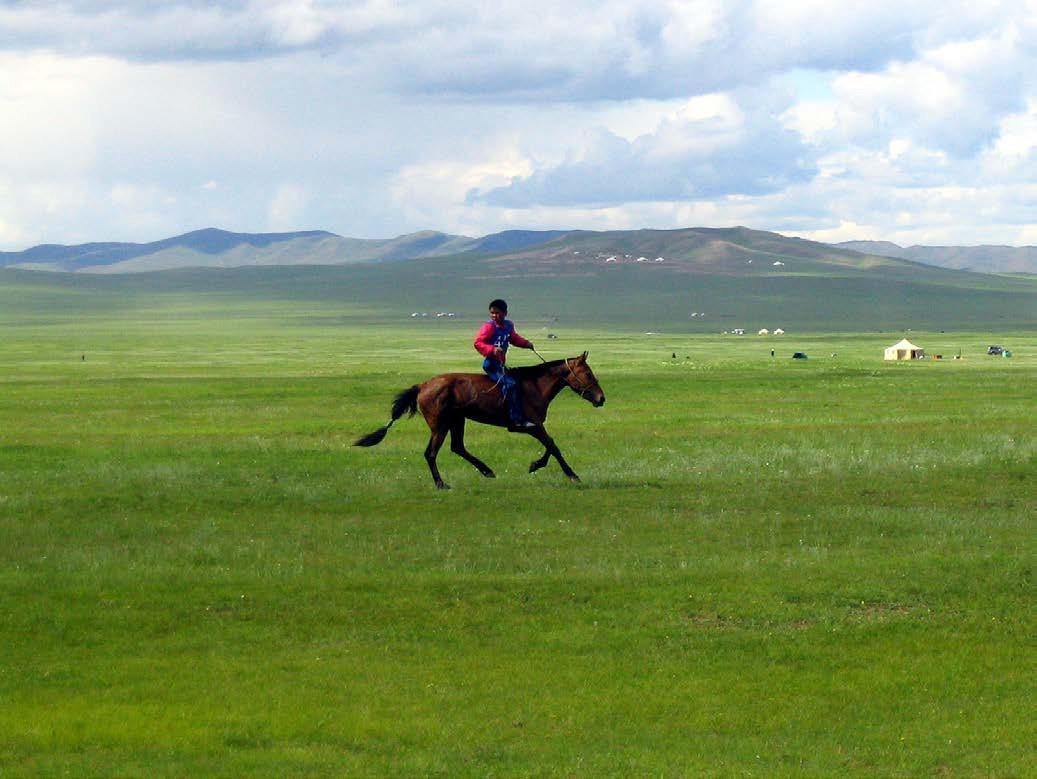
Periodic Turkic migrations into Central Asia transformed the sedentary culture of the region. These steppe peoples lived by practicing pastoral nomadism, a way of life centered around herding that most likely predated the Turks but was eventually adopted by them. Their culture was utilitarian in nature and provided all the necessities for life on the great plains of Central Asia, including food, clothing, shelter, and transportation. In order to maintain their pastures, these horsemen followed a fixed, seasonal pattern of migration because they did not want their flocks to overgraze. During the winter, for instance, they camped in foothills and mountain valleys, where it was warmer at lower altitudes. There they built fixed shelters with one main objective: survival. The oral tradition, which included songs, epic narratives, and parables, flourished during the inhospitable winter months. In the spring, the nomads made a ten-day trip to the prairieland to graze their herds on fresh grass that just emerged from mountain runoff. There the women and children erected a central camp, usually comprising four yurts (round tents), while the men divided the flocks into their specific pastures. They established about ten satellite camps around the central camp, with each herd positioned about ten to twenty miles from the center. This separation of camps minimized the potential threat that their enemies posed to their herds. During the summer, they traveled to mid-mountain fields, where it was cooler and offered access to water. Covering about ten miles per day, it took them approximately fifty days to reach this campground. Finally, in the fall, they returned to the steppe in order to make provisions for the harsh winter. These preparations included drying and preserving their meat and taking milk from their animals.
Enhanced mobility was the key to the survival of pastoral nomads. They actually spent a good portion of their lives on horseback and were accustomed to moving over long distances, taking all of life’s necessities with them. This allowed them to retreat quickly from rival attacks or areas afflicted by natural disaster. Though their way of life appeared seemingly innocuous, it enhanced the ability of these horsemen to expand rapidly and conquer neighboring groups. Additionally, the annual Great Hunt served as a military proving ground that helped them hone their fighting skills. In preparation for winter, tribes deployed groups of mounted men, who dispersed in different directions, with the intent of driving every animal within a set perimeter inwards to converge at a pre-established central point. With great coordination taking place over vast distances, these migrants learned how to coordinate their movements based on a color scheme of arrows and whistling patterns. Their herding tactics easily translated to military tactics and proved devastating in combat.
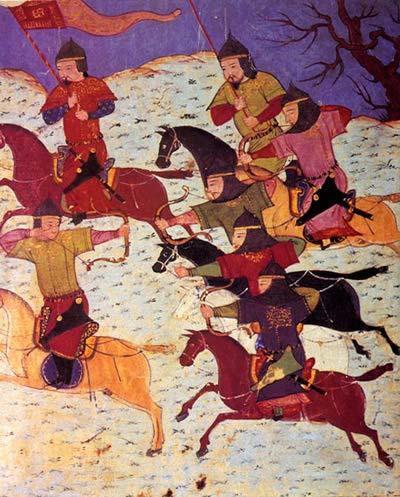
Nomad society was certainly capable of waging war. Their ability to shoot from horseback provided them with a mobile and lethal means to overcome slower, infantry-based armies. These horsemen carried portable, three-foot-long recurve bows capable of piercing enemy armor from over 450 meters. Metal enabled a rapid rate of fire without damaging the archer’s fingers. Raised hunting and herding from horseback, nomads even learned how to sleep in the saddle of the Mongol Horse, their indigenous horse. Though not tall in stature, these sturdy mounts displayed impressive endurance and allowed groups to traverse great distances, often up to 160 kilometers per day. The speed with which they could cover territory on their steeds often confused sedentary forces and multiplied the terror factor. Native to the region, these horses were able to forage for themselves and survive on their own. Nomads did not require supply lines and could, therefore, remain on campaign for an average of three years. The combination of the skills acquired from herding, the double-compound bow, and the Mongol Horse translated to a formula for political domination of Central Asia, at least until the arrival of Genghis Khan and the Mongols.
Turkic domination of the region began on the battlefield, where the strategies of steppe warfare proved devastating to infantry-based armies. The first stage of the nomad battle strategy often commenced with a feigned retreat, in which a group of their cavalry engaged the adversary, retreated, and encouraged their opponents to follow them. This technique lengthened the lines of their challengers, as they pursued the “retreating” Turkic cavalrymen, who were busy shooting backwards from horseback. The next stage of battle involved outflanking the enemy and enveloping them. They then showered their foes with arrows, the objective being to pin the opponent in place. This alone was often enough to break a sedentary power. When fighting against another steppe power, their reserves charged the opponent’s lines so as to break their forces into pieces and finish them off piecemeal. Most importantly, because of their limited numbers, the Turkic horsemen were reluctant to risk fighting an enemy that they did not believe they could defeat; instead, they would poison water wells, scorch the earth, and retreat. The Mongols would later employ similar battle tactics that allowed them to conquer the whole of Central Asia.
11.7 ISLAM
Islam was not the first foreign religion to arrive in Central Asia. In fact, the region had already been exposed to many foreign systems of belief prior to the coming of Islam in the seventh century. Local merchants conducting long-distance trade along the Silk Road came into contact with many different religious doctrines. Generally, intellectual diffusion is not a one-way street, as western ideas traveled eastward and eastern concepts filtered into the west. In this manner, the Silk Road carried Buddhism, Judaism, Zoroastrianism (an Iranian religion with both monotheistic and dualist elements), Siberian Shamanism, and even Nestorian Christianity to Central Asia. The great number of religions found in the area at the introduction of Islam testified to the great tolerance of the region. By the tenth century, however, all of the non-monotheistic faiths had disappeared from Central Asia in the aftermath of Islamic conquest.
It was Qutayba ibn Muslim (669–716) who expanded the presence of Islam in Central Asia during the eighth century, as the general’s forces swept into the area, defeated the Persians, and by 715 CE completed their conquest of Transoxiana, the region located beyond the Oxus River. A decisive Arab Muslim victory over the Chinese at the Battle of Talas River in 751 secured Central Asia and repulsed the only major challenge to Islamic rule. The triumph over the Chinese made it possible for Islam to become entrenched in the region. The Persian Samanids (819–999) made Islam the official state religion and established a school of theology in Bukhara. But Islamization did not take place overnight; instead, it took centuries. Transoxiana slowly Islamicized, though it never Arabized. The peoples in the area remained culturally Turkic and Persian. Central Asia retained its Turkic and Persian languages, albeit with a heavy Arabic influence in religious vocabulary.
It took generations for Islam to become fully ingrained in the culture of Central Asia. Unlike other places, where the religion filtered into society from the bottom up, as was the case in Southeast Asia, Islamization in the region occurred from the top down. Local leaders submitted to the faith in order to maintain their social status and elite position in society. The conquerors offered the Central Asian nobility important positions in the administration so long as they professed Islam, providing the opportunity for the native elite to rule in their own right.
Islam also displayed a remarkable ability to assimilate the great varieties of indigenous Central Asian frontier customs as it advanced through the area, allowing some traditional practices to remain so long as it accelerated conversion. By accepting certain harmless practices in order to Islamicize Central Asia, these Muslims mirrored Christian efforts to Christianize Eastern Europe.
11.7.1 Sufism
The Islam of Central Asia differed greatly from that which originated in the Arabian Peninsula. This vast region embraced Islam, remaking it into a syncretic faith that was culturally its own. Essentially a sort of mysticism, or folk Islam, Sufism in the area emerged from the fusion of Islamic sedentary civilization and Buddhist nomadic culture. Central Asians were generally receptive and tolerant of foreign beliefs, but in order for the faith to take root in the area, missionaries had to make some concessions to the native, specifically pastoral-nomadic culture. The urban-dwelling and agricultural populations of the region generally accepted Sunni Islam and the law of the Sharia; however, the culture and lifestyle of the itinerant peoples of the steppe did not readily conform to the rigors of Islamic law. Sufism helped convert these tribes to Islam, in part due to its doctrinal flexibility. What arose from the mix of orthodox Islam and Turkic pastoral nomadism was a uniquely Central Asian brand of Sufism.
In this context, Sufis evangelized to groups on the frontier of Central Asia. Actually, Sufi merchants were largely responsible for bringing Islam to the region. Central Asian Sufi orders such as the Yasaviyah established themselves along trade routes in order to reach out to travelers. These missionaries also proselytized to the Turkic communities on the steppe. Meanwhile, the Naqshbandi Order, operating in travel lodges, spread Sufism by ministering to Iranian and Tajik peoples. The followers of these Sufi orders believed that they could better disseminate a form of the faith that was more loving and caring.
11.8 THE MONGOL ERA
The Mongols greatly expanded into Central Asia during the thirteenth century. There they reunited with the Turkic groups who had been expelled from the Orkhon Steppe over the course of a millennia. The Mongols confronted many Turkic peoples who had radically altered their existence since their days on the plains and adopted a stationary way of life.
At this point in time, forces indigenous to the region shaped the world around it; foreign influence waned as a consequence of nativism. The Mongols created the largest land empire in history, as Central Asia externalized the violence of the steppe, yet it was with enormous difficulty that they even united as a people. Perhaps the greatest obstacle for them to overcome was their own divisiveness. Inter-tribal strife was commonplace, but once they united, the Mongols expanded deep into Russia, China, India, and the Middle East.
11.8.1 A New System for Unity
It was Temujin (1206–1227), later known as Genghis Khan, who brought this fractured people together and developed a method of governance and expansion that lasted long after his death. Born into the aristocratic Borjigin Clan, most likely in 1167, Temujin’s success related to his convictions. Inspired by oral tales of past glory, his personal charisma and sense of fate enabled him to survive a youth of life-threatening privation, eventually bringing the various Mongol tribes together.
With a keen awareness of his own destiny, Temujin was inspired to achieve greatness. He had a clear vision that he was predestined to function as a temporal ruler on Earth and exhibited a desire to claim universal lordship. Through a series of fights, he eventually subjugated local clans in eastern Mongolia. He then expanded his political control of the region through a marriage alliance to Börte Üjin, a member of the Olkhonut Tribe, which maintained friendly relations with Temujin’s Khiyad Tribe. The Merkit Tribe kidnapped his wife not long thereafter. Temujin heroically rescued her from this rival tribe, but she had been held in captivity for eight months and soon gave birth to their first son Juchi, whose paternity is uncertain.
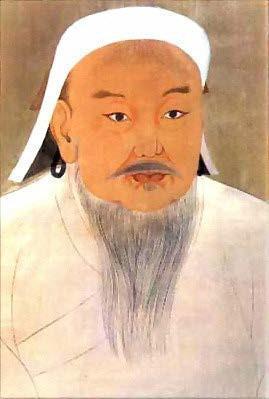
Despite his early successes at empire building, Temujin remained greatly outnumbered by his opponents and was forced to retreat to the Heights of Baljuna, located in modern-day Manchuria, where he convinced his followers to swear an oath of total allegiance to him and which called for them to fight for him until death. For their unwavering loyalty, he promised his supporters a share in his glory upon their victory. Some Mongol tribes yielded to Temujin by 1204 and agreed to recognize him as their leader, thus paving the way for a period of final unification of the Mongols.
Temujin demanded a high level of commitment from his people, endowing his forces with a coherency and unity of purpose. He also promoted allies based on merit, rather than by the traditional Mongol method of advancement based on position within the tribal hierarchy. His opponents, on the other hand, lacked his force of will and entered into a series of squabbles. Temujin took advantage of their internal fights, emerging victorious by 1206. The culmination of his ascendency took place that year at a Mongol assembly, or khuriltai, which appointed him as the first undisputed universal ruler of the Mongols, or khan. Uniting them under the authority of his position, Temujin adopted the name of Genghis Khan.
Genghis Khan presided over peoples who had experienced near-constant warfare since 1160. Previously, tribal confederations were loose alliances held together under charismatic khagans and punctuated by tribal warfare. He consolidated all of these diverse tribes and reshaped them into a single “nation,” endowing Mongol society with more cohesiveness, a key element to future expansion. He did this by developing a new political order that deviated from tradition.
Restructuring Mongol society into new administrative military units that provided the necessary impetus for expansion, Genghis Khan charged each of his commanders with a tribal unit that was responsible for controlling a particular pasture and fielding soldiers when needed. His system had the added effect of assuaging previous conflicts by assigning the members of one tribe to military detail with other rival tribes, thus emphasizing collective responsibility. By forcing the men from one tribe to stand guard over the pastures of other tribes, he weakened loyalty to ancestral lines and homelands, thereby reinforcing his own leadership.
Genghis Khan represented the ultimate source of justice in his newly-formed state, consolidating his position and making it more authoritarian. By embodying autocracy in the position of the khan, he made the title of khan institutional, not personal, building a new foundation for legitimacy. Previously, tribal leadership rested on charisma. Furthermore, the great khan could not be self-proclaimed but had to be recognized at a khuriltai.
His law, known as Yassa, originated as decrees delivered during war. Yassa remained secret, which allowed Genghis Khan to adapt it to changing circumstances. For example, he later incorporated cultural elements indigenous to Mongol society into the law. He based his code on shamanist principles, and it served as the social and political formula binding all Mongols together. It also strengthened Mongol, rather than clan or tribal, identification. It is believed that Genghis Khan himself directed the law, while his stepbrother Shihihutug served as the high judge, and his son Chagatai administered its execution.
11.8.2 Expansion
Genghis Khan encouraged Mongol expansion and the conquest of Central Asia through his somewhat untraditional tactics and policies. After subduing inter-tribal warfare, he followed tradition and exported the violence of the steppe. He offered incentives to his soldiers; the spoils of victory went to those who followed him into battle. Genghis Khan received ten percent of the loot and divided the remaining ninety percent between his commanders, who, in turn, distributed their portion amongst their retinue. This plunder also included the inhabitants of all subjugated lands, which resulted in the dramatic depopulation of conquered territory, as the khan received his share of artisans and craftsmen to be sent back to the itinerant Mongol capital.
In 1208, Genghis Khan targeted northern China for pillaging, but he quickly encountered considerable difficulties overcoming well-fortified Chinese municipalities. The Chinese had ringed their principle metropolises with moats and connected these major urban centers to several smaller satellite towns via underground tunnels. The Mongols had attempted to starve these cities into submission, but they lacked the military technology necessary to overcome walls forty-feet high and fifty-feet wide. To counter these challenges, they imported the technology necessary to defeat Chinese cities. Genghis Khan also compensated for a lack of native talent by incorporating foreign engineers into their army. He utilized Arab, Persian, and Chinese experts to solve the problem of defeating Chinese municipalities. Their knowledge of siege warfare enabled them to construct the siege engines capable of subjugating cities.
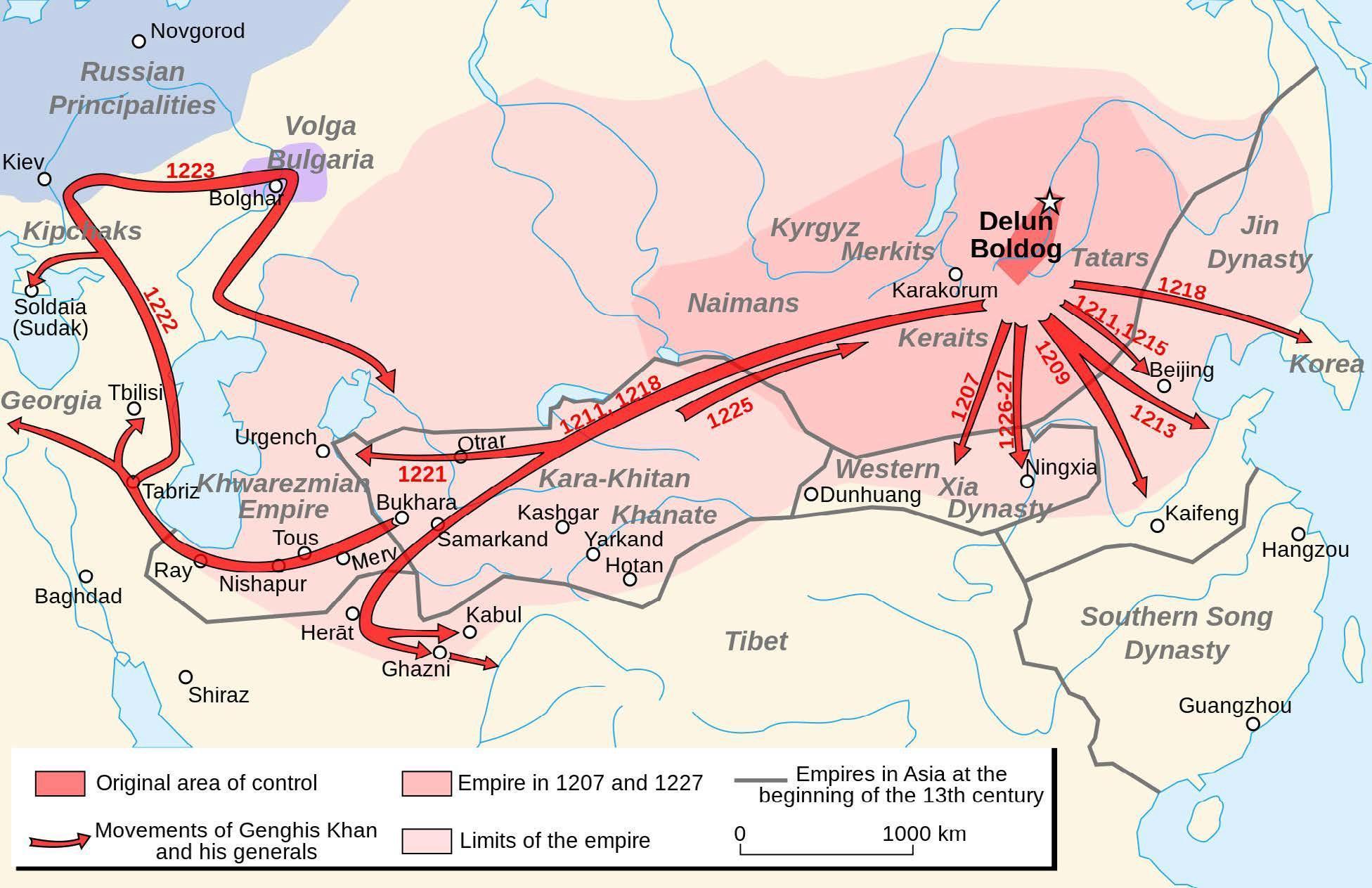
Adding these new sedentary peoples to the khan’s army inevitably caused problems, for these men hailed from distinctly different cultures and did not interact well with the Mongols. Genghis Khan, therefore, combined the mobility of his forces with the slow, bulky siege engines of the sedentary armies. While he kept his cavalry independent from the foreign engineers, mostly comprised of mercenaries, he blended these two disparate groups on the battlefield to his strategic advantage.
For the Mongols, building an empire proved much easier than maintaining one. The nomads possessed an inherent need to loot and plunder cities, and Genghis Khan took advantage of this innate desire by remaining on campaign. But the Mongols had difficulty understanding settled civilization and did not know how to maintain order in that new and different cultural milieu. Although they were able to instill fear in their enemies and easily forced many cities to capitulate, the Mongols co-opted local officials to ensure that taxes and tribute flowed freely back to their capital.
With his newly-constructed army, Genghis Khan returned to northern China again in 1210 and began a continuous campaign of destruction, primarily directed against the Jin Dynasty (1115–1234), an empire ruled by a Jurchen minority, a Tungusic people from Manchuria who would later call themselves the Manchu. In an early battle, the Jin put their Turkic cavalry up front to confront the Mongol horsemen. The Mongols managed to convince the Jin Dynasty’s cavalry to defect to their side. Genghis Khan subsequently advanced on the Jin capital of Zhongdu and entered into a prolonged siege. In November of 1211, the khan withdrew his troops to their winter pastures, only to return again in 1212. Genghis Khan attempted a rash assault of the city. He failed and was wounded in the process, thus the Mongols had to retreat once again.
Genghis Khan returned a fourth time in March of 1213, this time with the goal of conquering Korea, Manchuria, and all of northern China. Early difficulties campaigning against the Jin Dynasty prompted him to adjust his strategy. By laying waste to all of northern China, he aimed to annihilate their way of life, turning the region into vast pastureland for his herds. The Mongol leader surrounded Zhongdu and starved the city’s inhabitants into submission. He systematically obliterated everything in order to send a message to the inhabitants that it was futile to resist him. He even considered taking the city, brick by brick, and dumping it into the Yellow River. Fortunately for the residents of Zhongdu, a captured Chinese bureaucrat intervened and convinced Genghis Khan that it would be better to “sack” them every year through the collection of tribute. Mongol interest in rebuilding the city began soon thereafter, as Genghis Khan incorporated northern China into his state and opened the region to trade. This campaign represented the first significant addition of territory to the Mongol Empire.
As this chapter began, it was with the tenacious pursuit of the fugitive Küchlüg in 1216 that originally brought the Mongols into Central Asia. There they aroused the disdain of the local ruler in the area, the Shah of Khwarazm, Ala al-Din Muhammad II. Ruling over a loose confederation of disparate peoples, Ala al-Din Muhammad lacked security in his position as the Khwarazm Shah. Even his own mother was in intrigue against him. It was he who provoked the wrath of the Mongols. It all began when Genghis Khan sent a trade caravan, which probably included some spies dressed incognito as merchants, to the frontier post of Otrar, located along the Syr Darya. The shah believed that the trade mission was a mere deception meant to obscure an eminent invasion. Inalchuq, uncle of Ala al-Din Muhammad and governor of Otrar, improvidently convinced the Khwarazm Shah to have the entire party executed. An enraged Genghis Khan quickly dispatched another envoy and demanded that the governor of the city be put to death and have his head sent back to Mongolia as proof that Genghis Khan’s wishes were fulfilled. The shah executed this emissary too, a rash decision that precipitated the Mongol onslaught of Central Asia, which resulted in brutal massacres and a drastic depopulation of the region.

Ala al-Din Muhammad prudently fled the area, leaving the citizens of Khwarazmia to defend themselves against the forces of Genghis Khan. A total of five Mongol armies approached the Khwarazm capital of Samarkand from different directions, converging in 1220. The Mongols slayed the inhabitants of the city and constructed pyramid-like edifices out of their severed skulls. In 1221, they seized the city of Urgench and dumped it into the Amu Darya, piece by piece, diverting the course of the waterway. And yet, Khwarazm Shah Ala al-Din Muhammad still inexplicably escaped capture and absconded south. Genghis Khan deployed another force of some 30,000 troops under the generals Jebe and Sübedei to track him down and put him to death. The shah eventually sought refuge on an island in Caspian, where he died of pleurisy.

Meanwhile, Jalal al-Din Manguburti, the son of the Khwarazm Shah, assembled an army of resistance. Genghis Khan sent his stepbrother Shihihutug to apprehend Jalal, but he escaped to the Hindu Kush Mountains of Afghanistan. Jalal’s forces managed to defeat the Shihihutug led Mongols on the field of battle at Parwan in the spring of 1221, a rare loss. The Mongols actually respected Jalal for his display of valor and willingness to resist them. Jalal fled to India via the Khyber Pass with his pride intact. The khan headed south himself and defeated Jalal al-Din along the banks of the Indus River. Following their defeat of Jalal, the Mongols descended into India but quickly found the hot and humid climate inhospitable; they decided to return to Mongolia, arriving home by 1225. The Central Asia campaign had started as a punitive expedition but in the process had wiped out any type of resistance in the region.
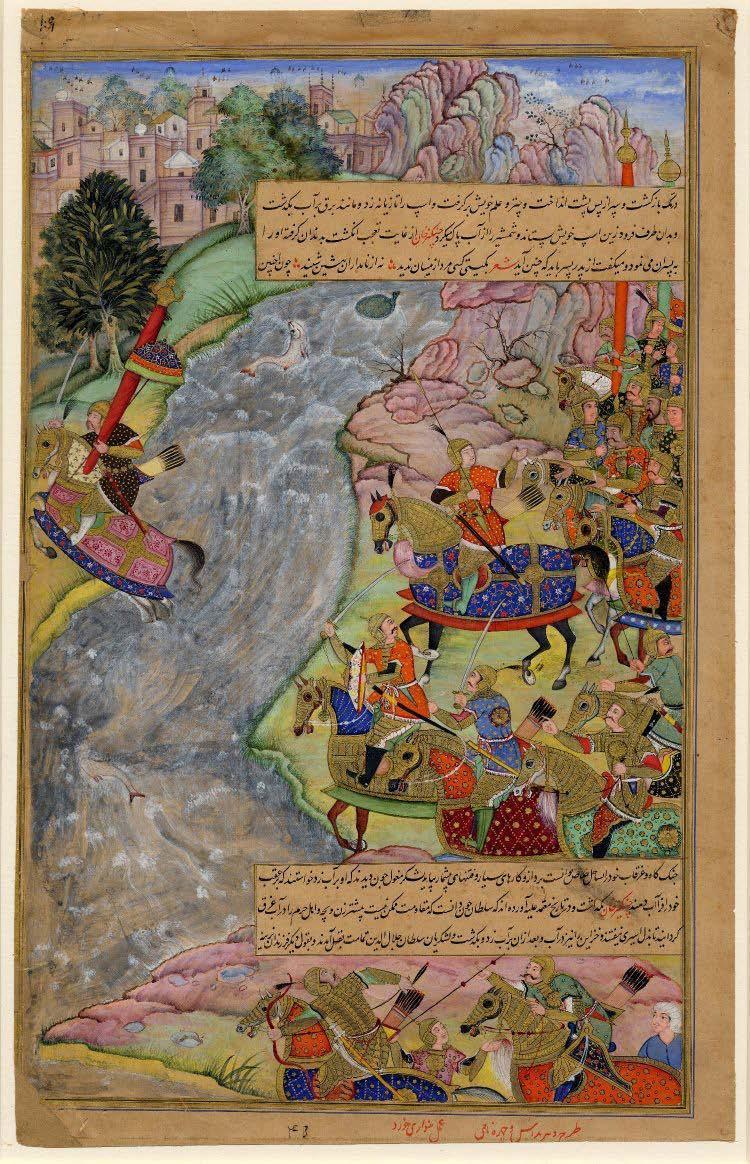
In the interim, Genghis Khan had ordered Jebe and Sübedei to explore and reconnoiter the West. Between 1221 and 1223, the two most gifted of the khan’s generals traveled towards Russia. In the course of their journey, they defeated the Georgians, Armenians, princes of Rus, and Kipchak Turkic tribes. Then they abruptly returned home. The purpose was not to annex the territory but to gather intelligence, which proved to be important to their campaign against the princes of Rus between 1236 and 1240. Meanwhile, Genghis Khan had died on expedition in southern China in 1227. Upon his death, the Mongols participated in a year of mourning, halting expansion.
11.8.3 Succession
The Mongols were the only steppe tribes whose empire actually expanded upon the death of its founder. In fact, most of the Mongol conquests actually transpired after the passing of Genghis Khan. Unlike previous tribal confederations, it did not implode because Genghis Khan had invented a safe and reliable means of transferring power. He also stabilized Mongol society and made it less fractious, constructing a framework for subsequent generations to follow. To maintain political legitimacy and inherit the throne under this new system, one had to trace their ancestry back to Genghis Khan through his wife Börte and her four sons, Juchi, Chagatai, Ögedei, and Tolui. This concept dramatically limited contenders for the khanate, mitigating future competition for succession. Only they possessed the required Genghis-Khanid legitimacy.
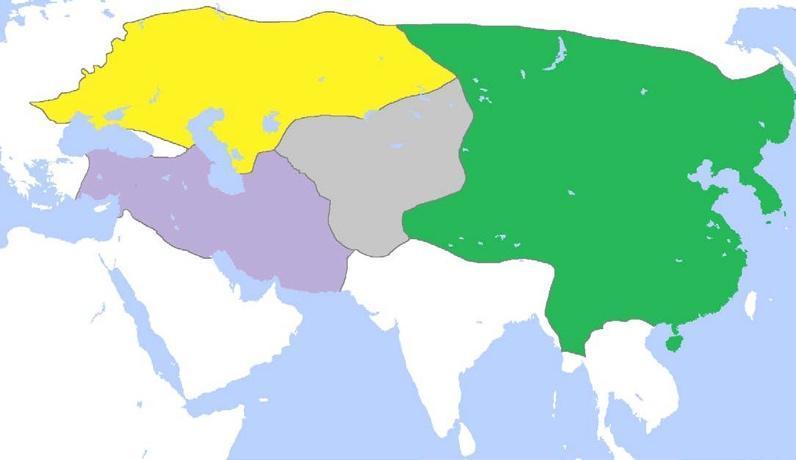
The khan’s plan to transfer power upon his death also fused older steppe traditions with his new vision. He bequeathed to his sons parts of the world yet unconquered so that they had to win these new areas. This stipulation produced an incentive for his sons to cooperate in order to collect their patrimony. Genghis Khan had divided the four patrimonial ulus, or states, amongst his sons. The four subsequent empires that grew out of these ulus included the Golden Horde, who were the descendants of Juchi and controlled Russia; the Chagatai Khanate, which traced its lineage to Chagatai and governed Central Asia; the Mongol-founded Yuan Dynasty in China, the progeny of Tolui; and the Ilkhanate of Persia, inheritors of the House of Hülegü and also the successors of Tolui.
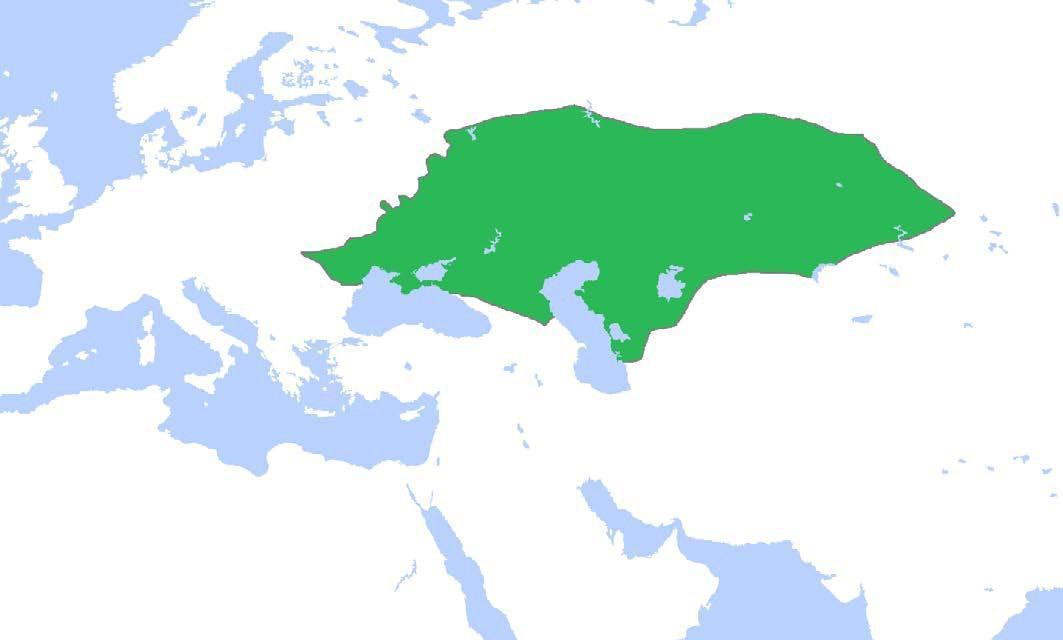
Prior to his death in 1227, Genghis Khan expressed a desire that his son Ögedei succeed him, a decision that affronted Juchi, his eldest, whose lineage was questioned. Fortunately for the Mongols, Juchi’s death preceded that of his father’s, narrowly averting a potential civil war. A khuriltai in 1229 confirmed the khan’s wishes, and it was under Ögedei that the Mongols realized their destiny of world domination. Between 1230 and 1233, Ögedei’s troops defeated the remnants of the Jin Dynasty in central China. Then they focused their attention on Russia, as they had actionable intelligence on the divisions among the Russian principalities dating to a 1223 reconnaissance mission that utterly crushed a coalition of Russian and Kipchak princes. In 1236, Ögedei launched his campaign in the dead of winter and used rivers as frozen ice highways. By the end of 1237, they had taken the Black Steppe, Vladimir, and Riazan. It was only some fortuitous flooding that prevented the complete destruction of Novgorod. The Prince of Novgorod was, however, sufficiently impressed by the Mongol onslaught and voluntarily agreed to pay their tribute. The Mongols commenced a devastating attack on the city of Kiev in December of 1240, culminating in a nine-day siege. Following Mongol military tradition, they ultimately destroyed the city as retribution for its resistance. The Mongols steamrolled the Hungarians soon thereafter and left the region in ruins en route to Vienna. By December of 1241, their forces were approaching the outskirts of the city, and no military power in Europe was capable of withstanding a Mongol attack.
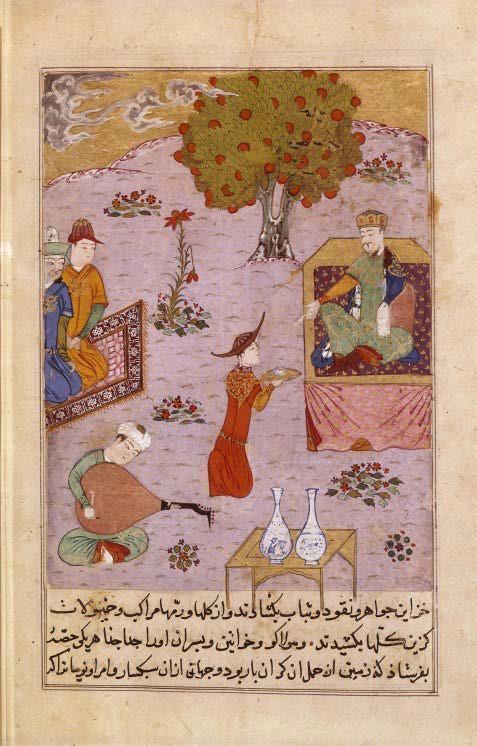
Fortunately for the Viennese, Ögedei died that very same month, and a one-year period of mourning ensued. The Mongols were summoned home in order to choose the next great khan. What was supposed to be a quick election turned into a five-year ordeal because Batu, son of Juchi and grandson of Genghis Khan, refused to return to Mongolia for the khuriltai. This founder of the Golden Horde believed that he would not be chosen and knew that his relatives could not officially convene a khuriltai without him, thus preventing the body from proclaiming the next great khan. It was Ögedei’s death and Batu’s independence of thought that saved Europe from Mongol conquest.
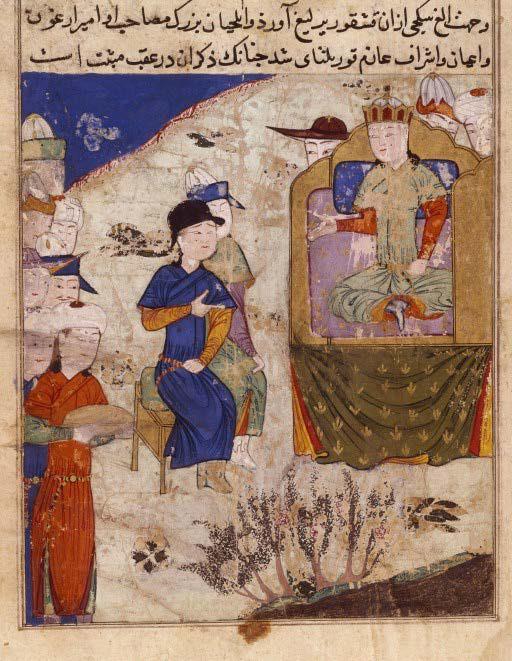
The khuriltai finally proclaimed Güyük, eldest son of Ögedei, the next khan in 1246. This was not a legitimate election, though, because of Batu’s conspicuous absence. Güyük quickly dispatched an army to punish Batu for meddling in the political process of succession, but Batu had already arranged for his cousin’s assassination in 1248. Güyük’s death led to another period of paralysis. A khuriltai eventually nominated Möngke, Tolui’s oldest son, as the next great khan in 1251. Now Möngke had to deal with the problem that Batu presented. He was willing to allow for Batu’s autonomy so long as he recognized Möngke as the legitimate khan. It was at this point that Batu’s horde become the Golden Horde. He adopted the moniker of “golden” because he was asserting his independence.
Batu died in 1256, and his younger brother Berke became the first khan of the Golden Horde to accept Islam. This sudden conversion to Islam caused systemic problems in the Mongol Empire because different parts of the four lines of Genghis Khan would adopt different faiths, resulting in political divisions that aligned with religious divisions. As a Muslim, Berke spurned his Buddhist cousins and established firm links with the Turkic Mamluk Sultanate in Egypt, thus making an alliance based on faith with a power outside of the Mongol Empire.
Genghis Khan’s empire had exceeded normal steppe expectations, and with potential fault lines emerging already, his vision of a politically unified empire was never truly realized. A series of civil wars erupted not long thereafter that fractured the Mongol Empire. First came the Toluid Civil War (1260–1264), then the Berke-Hülegü War (1262), and finally the Kaidu-Kublai War (1268–1301). These three wars had the combined effect of undermining the great khan’s authority, and the empire ended up breaking apart along the lines of the patrimonial ulus, with each moving in their own direction. In fact, the successors of Kublai Khan (1260–1294), who presided over the Yuan Dynasty in China, could not even convene a khuriltai to appoint a great khan following his death. By 1294, there was neither fiction nor façade of a unified Mongol Empire. It was the end of a unified political unit.
11.9 THE KHANATE OF CHAGATAI
Chagatai (1226–1241), the second son of Genghis and his wife Börte, had participated in his father’s campaigns, and in 1227, he claimed his patrimonial territory designated as between the Caspian Sea and the Tarim Basin. The origins of the Chagatai Khanate shaped its political and demographic character; Chagatai obtained the core of Central Asia, a personal pastureland located along the Kazakh steppe. He also received the settled lands to the south in modern-day Uzbekistan. Chagatai never demonstrated ambition for the position of great khan; rather, he played an important role helping his brother Ögedei exercise authority and uphold Yassa. In doing so, Chagatai served as the glue that helped hold the Mongol Empire together.
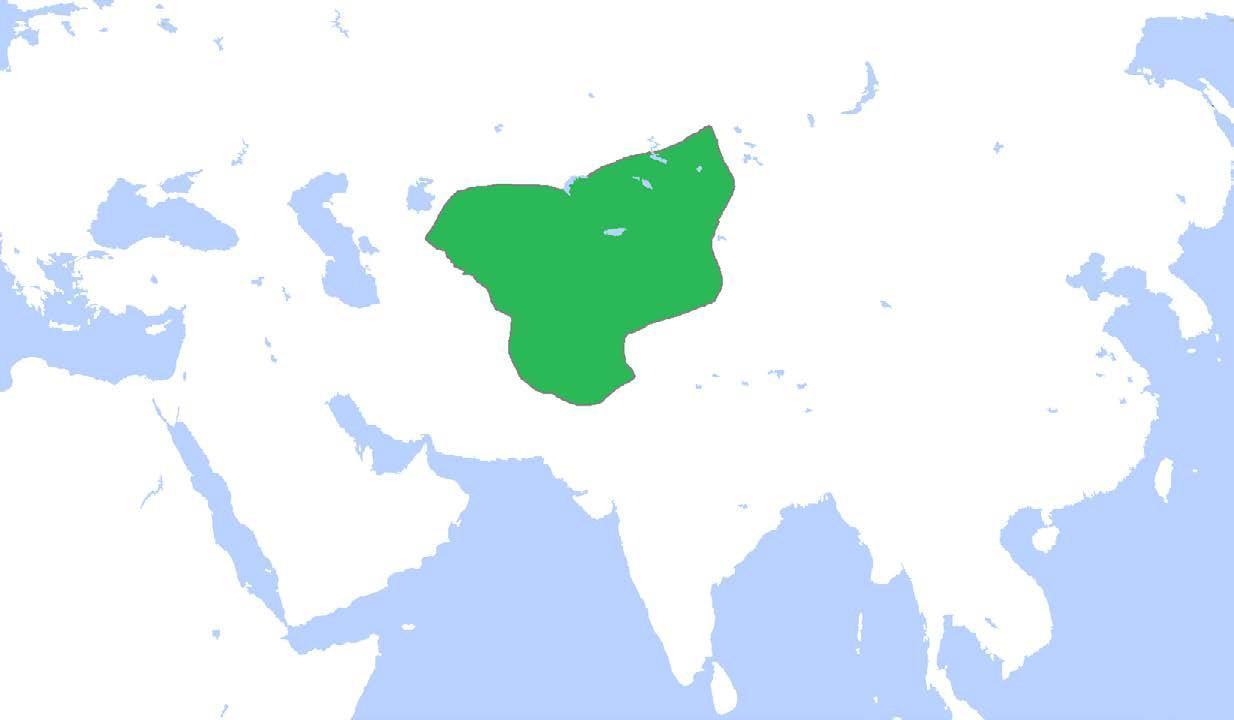
As was the case with his father, Genghis Khan, Chagatai had trouble coping with the cultural differences that existed between nomadic steppe and settled societies. His solution to the conflict between these two civilizations was known as Inju, a dual-administrative system and a form of indirect rule. Inju was a political concession designed to separate the two incompatible cultures, allowing both to maintain their own traditional laws yet remain subject to the authority of Chagatai and his descendants. Chagatai was conscious not to force Yassa on sedentary Muslim cities; however, it continued to be exercised on the plains. In agricultural and urban areas, a bureaucratic tradition with a Muslim administration persisted. So long as these Muslims did not openly resist Mongol control, they could go about their daily business, free from Mongol interference in their life. It was in this way that the steppe continued to abide by customary Mongol law, while in the south, the people of the cities lived according to the Sharia, or Quranic law.
Inju was also an economic arrangement granting the Mongols a share of the resources produced in sedentary lands. The Mongols rewarded those who cooperated in governance with a portion of the profits; those who participated in Inju were entitled to their allotment of the common imperial settled possessions. At first, all of the conquered towns remained the property of the khan, but over time, access to the wealth of the urban areas extended to the nomads who took part in Inju.
Although Inju was a practical solution to the difficulty of governing the two separate societies, it ultimately did not resolve the problem of uniting the sedentary Turkic population and the nomadic Mongols since it failed to accommodate the needs of either society. Actually, it encouraged friction between the two civilizations because it placed hardships on both peoples. While the horsemen benefited handsomely from Inju, they considered it incompatible with their traditional practices because it forced them to climb down from their steeds and settle down in the cities. Yes, the Mongols did receive tribute, slaves, and status as compensation for the inconvenience of ruling over settled lands, but the costs of sustaining this empire were heavy. It was just too demanding for them to uphold. First, the maintenance of empire disrupted the nomadic way of life because they often had to join in exhaustive campaigns, lasting years at a time. Second, the nomads were unaccustomed to a considerable amount of government interference in their daily routine. Increasingly, they viewed the prospect of governing an empire as a burden and preferred to revert to a pastoral lifestyle on the prairie. They sought more independence and stability, so they consciously began to defect from the system and return to their pastures.
Those living in the settled lands to the south chaffed under Inju as well. Though they recognized that government remained an essential part of life, Inju encumbered urban-dwelling and farming peoples too. The Mongols stressed this population by raising additional taxes in an unpredictable and disruptive manner. This annoyed the city folk, who were accustomed to more regular taxation. Ultimately, Inju did not mesh well with either lifestyle. The practice rested on force, not utility. The Mongol state sustained two different societies that often remained in conflict, so it stayed in a state of permanent instability.
11.9.1 Turko-Mongol Fusion
The Mongols were the first to unify the Eurasian steppe, and their occupation of the region corresponded to a wholesale takeover. As they migrated southwest down the steppe, they failed to displace the Turkic peoples already established in Central Asia. Early on, the dominant Mongols offered these Turkic groups a deal to either merge with them or suffer harsh reprisal. So as the Mongols progressed westward, their armies gained strength, as more and more of the Turkic tribesmen joined them, resulting in armies that were mostly comprised of Turkic peoples, not Mongols. In this manner, the Turkic groups absorbed and assimilated the invading Mongols, a process known as Turkification; the conflict between the two cultures faded over time and eventually led to a fusion of Turkic and Mongolian societies. Over time, these Mongol pastoralists presiding over a sedentary Islamic culture slowly Turkified. They quickly became a Mongol minority governing a Turkic majority.
There were numerous points of contention between the two groups but also many commonalities. Both societies had originated on the steppe in modern-day Mongolia, and while the Turkic groups had settled down over the years and adopted more of a sedentary existence, many of the principles of pastoral nomadism still lingered in their culture. Both adhered to a patrimonial distribution of inheritance. Also, both the Turkic groups and the Mongols organized along tribal lines, and each followed a pattern of co-opting one tribe into another, thus facilitating a fusion of the Mongols with their Turkic hosts. For this system to work, though, the Mongols had to speak the idiom of the people they ruled. So instead of the Mongols imposing their language on the majority of the population, the Mongol elite learned Chagatai, a Turkic tongue.
For many years, religion remained the only major distinction between the two societies, but once the Chaghatayids converted to Islam in 1333, this conspicuous difference disappeared. While the Mongols adopted the creed and language of the Turkic Chagatai, these Turkic peoples incorporated the Mongol political concept of Genghis-Khanid legitimacy.
11.10 THE KHANATE OF THE ILKHANS (1265–1335)
Hülegü Khan (1256–1265), grandson of Genghis Khan and son of Tolui, served his brother Möngke (1251–1259), the great khan, and campaigned through the Middle East, where he whipped out the Assassins, a secret order of schismatic Shia entrenched in the mountains of Gilan province in 1256. He also destroyed the Abbasid capital of Baghdad in 1258. By 1260, Hülegü controlled parts of Armenia, Iraq, and Anatolia; all of Azerbaijan; and all of Iran. Kublai Khan (1250–1294) had awarded his brother Hülegü the title of Ilkhan, a secondary khan who remained subordinate only to the great khan in Mongolia. This portion of the empire became known as the Khanate of the Ilkhans.

The Ilkhans were a Mongol minority ruling over a Muslim majority; religious problems plagued the Ilkhanate for much of its existence. To begin with, Hülegü, a Nestorian Christian, who later converted to Buddhism on his deathbed, had sacked Baghdad, one of the most politically important cities in the Islamic world, an act that alienated him from his Muslim cousin Berke Khan, ruler of the Golden Horde. The conversion of the Golden Horde to Islam had presented a real problem, for the Ilkhans had initially championed Buddhism in Iraq and Iran. As animosity continued to mount between the two parts of the Mongol Empire over religious differences, we see growing ties of alliance between the Muslim Golden Horde and their coreligionists, the Mamluk Sultanate of Egypt, against the Ilkhans. Belief transcended blood, as one part of Mongol Empire allied against another with an outside source. Faith-based civil wars consumed much of the reign of Abaga Khan (1265–1282). These wars were rooted in the Ilkhanate’s inappropriate treatment of their Muslim population. The Golden Horde’s alliance with the Mamluks threatened the Ilkhanate, and yet no longer could Abaga rely on the full might of centralized Mongol power; he was forced to appeal to Kublai Khan to assuage the hostilities between the Ilkhans and the Golden Horde.

Much of the religious conflict during the early Ilkhanate related to doctrinal differences between Islam and the traditional Mongol way of life. The most stubborn problem for the two was the contradiction between the traditional Mongolian method of animal slaughter, which required that no blood be spilled, and the Islamic code of cleanliness, which necessitated that all blood be drained. Each side was appalled by the other’s customs. Furthermore, as practitioners of rigid monotheism, Muslims found the Mongol worship of religious images repulsive, a ritual strictly forbidden in Islam.
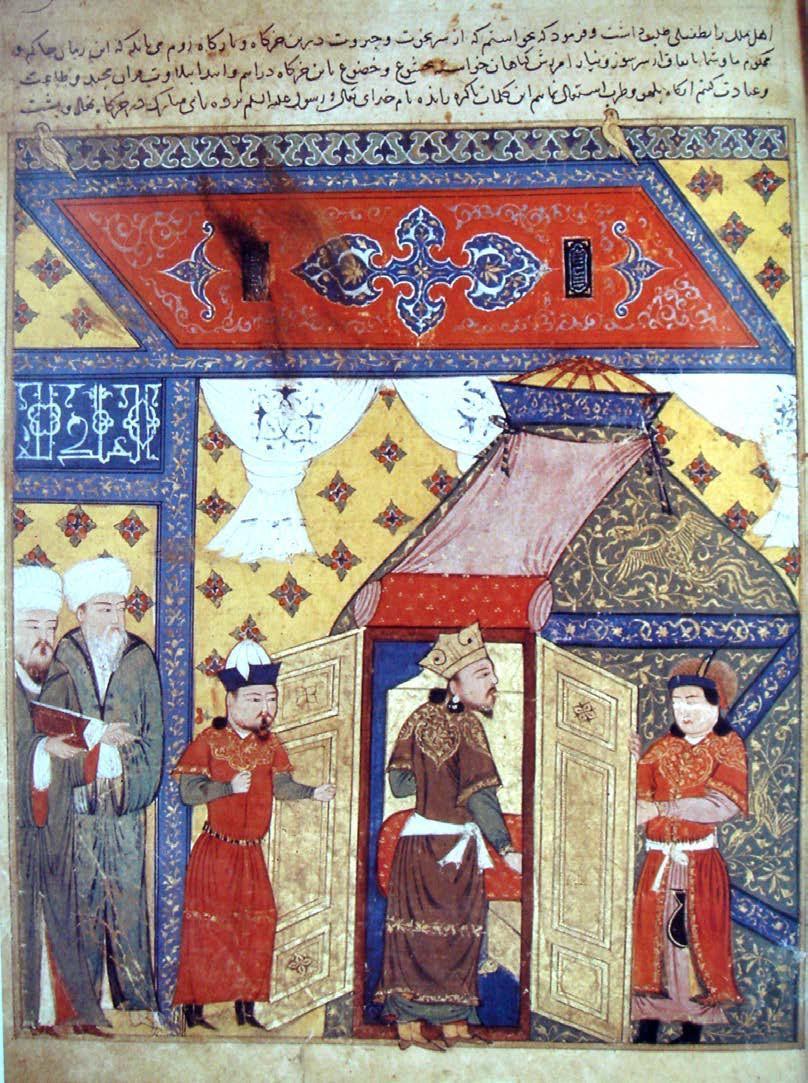
While spiritual troubles remained a persistent problem for the Ilkhans, the economic situation deteriorated too. Gaykhatu Khan (1291–1295) practically emptied the royal treasury with profligate spending. He experimented with paper money recently adopted from China to compensate for his wasteful expenditures, but overprinting resulted in massive inflation. The Ilkhans also tried to extract the maximum amount of tribute from the countryside to offset declining revenues. This led to an abuse in tax gathering, known as tax farming, in which rulers sold contracts for the collection of revenues to the highest bidder. This method of tax collection provided a strong incentive to despoil peasants.
It was Mahmud Ghazan (1295–1304) who solved the Ilkhanate’s continued religious and economic problems. Despite the early looting and plundering indicative of a Mongol conquest, the Ilkhans eventually reactivated the Silk Road and promoted transcontinental trade. The newfound safety of the route throughout Eurasia stimulated trade and encouraged many different kinds of cultures to come together. Ghazan attempted to reform the tax policies that had led to the maximization of taxation. Cities did revive, but the long-term negative consequence of conquest continued to be felt by the peasants who suffered from prolonged violence.
Mahmud Ghazan was the first Ilkhan to convert to Islam, thus rehabilitating their image in the eyes of their Muslim subjects and making their rule much more acceptable. Their new public stance towards Islam moderated persistent conflict and paved the way for cultural flourishing. Ghazan patronized Ilkhanid art, scholarship, and science. Ilkhanid art reflected Chinese influence and helped contribute to Persian artistic development. In terms of scholarship, the first true history of the world was completed under the sponsorship of Mahmud Ghazan. Written by Rashid al-Din Hamadani (1247–1318), the book was richly illustrated with watercolors and portraiture in the Chinese style. Through his travels in the service of the Mongols, Rashid al-Din had become perceptively aware of Ilkhanid Persia’s cosmopolitan culture. It was Rashid al-Din, a Jewish convert to Islam, who had convinced Mahmud Ghazan to adopt the faith in order to be more attuned to the beliefs of his peoples. Regarding science, the Ilkhands attempted to amass large amounts of astronomical data from China to Europe. With unprecedented accuracy, they became very good at predicting lunar eclipses. Their data was used throughout Eurasia.
Much like the Mongols in Chaghatai Central Asia, we see a Persian-Mongol fusion, as they began to identify with Persian culture and speak the Persian language. As they bonded with Persia, they adopted Islam and began to promote Persian as the written language of their land.
11.11 TIMUR
It was under Timur (1370–1405) that Central Asia moved to the fore of world events. He is also known as Tamerlane, or Timur-the-lame as a result of battlefield injuries to his right hand and leg. Timur attempted to soothe the persistent differences that existed between the nomadic steppe and sedentary societies and actually developed a political arrangement that could harness the best attributes of each society, without the dangerous side effect of communal violence associated with combining the two civilizations. He also constructed a new political and military machine that was deeply ingrained in the political background of the Chagatai Khanate, even while he acknowledged that Inju satisfied neither the nomad nor the settled society and eliminated the practice. Astutely recognizing that serious conflict existed between these two incongruent cultures under his control, Timur provided a framework for both societies to live in harmony.
Born in 1336 near Kesh in modern-day Uzbekistan, Timur came out of Central Asia and was a product of the Turko-Mongol fusion. He descended from an aristocratic Mongol clan, but he was raised as a Muslim and spoke a Turkic language. Although Timur himself was a native to Transoxiana, he could not assert Genghis-Khanid legitimacy. Unable to trace his ancestry to Genghis Khan, he could not take the title of khan in his own right. Timur understood that because he did not have the correct pedigree, he would have to earn it. His solution was to take the title of emir, meaning commander, and rule through a Chaghatayid puppet khan acting as a figurehead. The emir also married into the family of Genghis Khan. While the law of descent was not intended to work this way, Timur changed it to accommodate his children, who would be able to claim Genghis-Khanid legitimacy.

To strengthen the security of his position as emir, he constructed a system of support that ordered his political connections in a series of concentric rings. In his primary circle resided his family and close allies. The second ring consisted of loyal tribes and Timur’s own Barlas Clan, from which he traced his lineage. The third circle was made up of those peoples Timur had defeated on the battlefield; the second and third rings balanced one another. The outermost bands included Timur’s hereditary professional administrators and bureaucrats, soldiers from the plains serving in his cavalry units, and finally the Persian urban and agricultural populations, from which he recruited his infantry and siege units.
Like many transitional figures in history, such as Suleiman the Magnificent, Timur bridged the medieval and modern worlds. He attempted to imitate Genghis Khan’s success in the field and designed a novel military machine that was well adapted to the environment in which he lived. His military was the product of a Turko-Mongol fusion, employing Turkic siege techniques and the Mongol cavalry. Unlike Genghis Khan, however, Timur increasingly combined his cavalry, siege, and infantry units, placing his heavy cavalry at the center of formations. His army also utilized an early form of artillery. He ventured to monopolize the market on gunpowder technology so that other powers could not benefit from it.
Timur was determined to keep his volatile army occupied, so they would not be a burden to the sedentary population in his realm. It was in this context that he developed a formula for success that promoted peace at home and war abroad, a policy that best served the interests of the merchants and townspeople. He externalized the violence of the steppe and destroyed all of the other trade routes that bypassed his territory. Timur attempted to reactivate and dominate the Silk Road and diverted trade to his lands in order to help rebuild the cities that had been damaged from years of Mongol and nomad rule. He did not aim at permanent occupation or the creation of new states; he just wanted to devastate, even going so far as to campaign against the Golden Horde, Delhi Sultanate, and the Ottoman Empire, all in an effort to redirect trade in his direction.
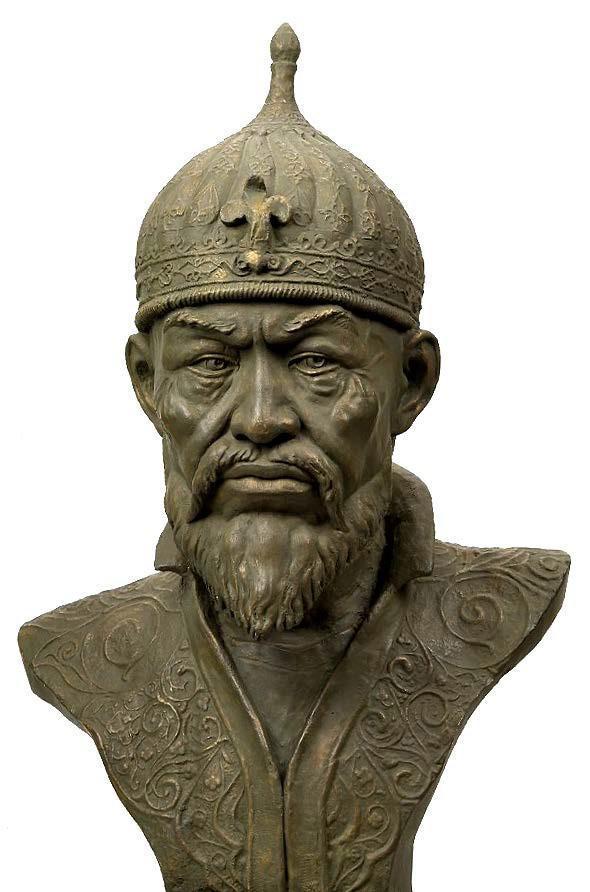
Timur began his military campaigns attempting to secure the back door of the steppe. During this period, which lasted from 1370 to 1385, he conquered and subdued Mogholistan to the northeast, with the aim of securing the core central land route of the Silk Road. (The Chagatai Khanate had already been divided into two parts by the 1340s, Transoxania in the west and Mogholistan in the east.) Then he engaged the Golden Horde between 1385 and 1395. The Golden Horde had been the master of the northern trade route that bypassed Timur’s territory. In order to eliminate this option, he went to war against them in order to divert trade toward his lands. Timur showed his strategic genius in these expeditions. He put the pieces of his army together in such a way so that he could take his enemies on in their arena and on their terms. In this manner, Timur crushed Tokhtamysh, leader of the Golden Horde, in 1395. During the course of this campaign, Timur destroyed their principle trade cities of Astrakhan and Sarai. An interesting byproduct of Timur’s campaign against the Golden Horde was that it precipitated the rise of the Grand Duchy of Moscow. He had weakened the Golden Horde to such an extent that it made it possible for Moscow to throw off the Mongol yoke (although that would take a few more decades, until 1480).
Timur raided into India from 1398 to 1399 and dealt a blow to the southern sea route that connected the West to Asia. This expedition was primarily for looting, since he never intended to conquer and annex the territory of Nasir-ud-Din Mahmud Shah Tughluq, the last member of the Tughluq Dynasty of the Delhi Sultanate. During this campaign, Timur’s tactical brilliance was on full display; he had an uncanny ability to adapt to any martial environment that he confronted. For instance, when threatened with a cavalry of war elephants, Timur responded by unleashing a pack of camels laden with incendiary material to charge the enemy lines. Shrieking dromedaries with their backs ablaze incited utter pandemonium among Nasir-ud-Din’s cavalry of elephants, who rampaged through the sultan’s own lines. Timur easily routed the sultan’s forces. When faced with the townspeople of Delhi rising up against their aggressors, Timur brutally sacked the capital of the sultanate and justified the violence in religious terms. His was a Muslim victory over the Hindu unbelievers of India.
In Timur’s final period of conquest, which lasted from 1400 to 1404, he campaigned against the Islamic far west, directing his army against the Ottomans. Actually, Timur had initially attempted to avoid conflict with the Ottomans, whose forces had earned an impressive reputation on the battlefield. In fact, Timur had even tried to negotiate with Bayezid I, the Ottoman Sultan, offering him part of Golden Horde’s territory west of Dnieper River. But these two expansionist realms inevitably came into conflict in eastern Anatolia. The conflict between the two empires began as the Ottomans expanded to the east and took control of some Turkmen tribes in eastern Anatolia already under the protection of Timur. The emir responded by taking some other Turkmen tribes under Ottoman suzerainty. Offensive missives replete with insulting incriminations ensued. Timur bided his time, waiting for the perfect moment to attack the Ottomans. In 1402, he launched a devastating attack into the heart of Anatolia, as the Ottomans were preoccupied with campaigning against the Hungarians. During the Battle of Ankara in 1402, Timur managed to convince many of the Ottoman forces to defect to his side. He captured the Ottoman sultan, who died in captivity three months later. Timur had not attempted to conquer the Ottomans; he just wanted to punish them for their unwillingness to cooperate. His Levantine expedition also seems to have been designed to weaken the western terminus of the Silk Road in Aleppo, Syria.
Timur died in 1405 while on a campaign against the Ming Dynasty. He had built an empire that spanned the breadth of Central Asia. Unlike Genghis Khan, whose empire continued to expand after his death, the sons of Timur and their followers squabbled over succession, leading to a series of internecine battles. Members of the Timurid Dynasty competed among themselves, with commanders switching loyalties. The empire consequently fragmented. The successors of Timur could not manage the difficulties of governing an empire, and it withered away quickly. The political situation resembled that which Chagatayids had to contend with, the steppe military that had been redirected, but with Timur’s death, they returned. A number of Timurid rulers followed; a weak state emerged from all this strife.
11.11.1 Terror and Destruction
Timur certainly committed what we would describe today as war crimes; there definitely was an element of terrorism to his campaigns. In fact, as an admirer of architecture, he is known to have constructed pyramids of human skulls. Extant accounts describe him slaughtering 100,000 Indian prisoners following the Delhi uprising. But not all destruction was the same; and there was a definite difference between that of Genghis Khan and Timur. The emir’s annihilation of the region was not meant to serve a utilitarian purpose so much as to inflict suffering. Genghis Khan used terror as a method to protect his troops, whereas Timur engaged in terror and destruction for pleasure.
11.11.2 Legacy
A product of the Turko-Mongolian fusion, Timur had been the first to reunite the eastern and western parts of the Chagatai ulus. His empire represents the construction of the political boundaries passed down to posterity; the maintenance of this space would define boundaries of modern-day Central Asia up to the twentieth century. Under Timur, we see growing political and cultural distinctions between Iran, Central Asia proper, and India begin to cement. In this context, we see a split taking place on the steppe that will lead to a differentiation of the Uzbeks and Kazaks. By the late fourteenth century, the tribes on the steppe to the north will become known to Muslim writers as Kazaks, whereas the tribes to the south will be increasingly referred to as Uzbeks, a differentiation that has continued to persist and helped to delimit modern borders.
11.12 CONCLUSION
Three forces combined to shape the course of Central Asian history: the Turkic migrations, expansion of Islam, and the Mongol conquest. Beginning in the second century BCE, waves of Turkic migrations entered the region. It is debatable whether or not they Turkified the original Iranian inhabitants or permanently changed the ethnic makeup of the area. Turkic tribes occupied the great steppe, Turkifying the region and endowing it with a more nomadic character. They also populated the agricultural basin of Transoxiana, displacing the original Iranian inhabitants of the area. Many of these Turks slowly settled down over time. These Turkic peoples displayed a unique ability to absorb the Islamic faith and internalize the Mongol conquest.
Islam transformed the religious adherence of Central Asia and left a lasting mark on the region as well. Transoxiana gradually Islamicized, but Turkic and Persian cultures persisted. Islamization incorporated native peoples in the process of conversion. As Islam spread through the area, the faith demonstrated an extraordinary capacity to incorporate local traditions, permitting some customs to linger so long as doing so accelerated conversion. Sufi missionaries made some compromises with the Turkic nomadic culture in order to establish the religion in the area. Sufism’s inherent flexibility helped to promote conversion, and the blend of orthodox Islam and Turkic pastoral nomadism created a uniquely Central Asian brand of the faith.
The Mongol conquest of Central Asia had the most immediate impact on the history of the region. Although the Mongols eventually Turkified over time, the legacy of Genghis-Khanid legitimacy remained. Genghis Khan had developed a secure and dependable means of transferring power which reduced the number of contenders vying for the throne; the Mongols did not collapse as a “nation” following the death of their founder. Genghis Khan bequeathed a legacy of political legitimacy to the region that would last until the twentieth century.
11.13 WORKS CONSULTED AND FURTHER READING
Adshead, S.A.M., Central Asia in World History. New York: Palgrave, 1993.
Allsen, Thomas T., Culture and Conquest in Mongol Eurasia. Cambridge: Cambridge University Press, 2001.
Christian, David. Inner Eurasia from Prehistory to the Mongol Empire. Oxford: Blackwell, 1998.
Findley, Carter Vaughn, The Turks in World History. Oxford: Oxford University Press, 2005.
Halperin, Charles J., Russia and the Golden Horde: The Mongol Impact on Medieval Russian History. Bloomington, IN: Indiana University Press, 1987.
Khan, Paul. ed., The Secret History of the Mongols: The Origin of Chingis Khan. Boston: Cheng and Tsui, 1985.
Morgan, David, The Mongols. Oxford: Wiley-Blackwell, 1996
Soucek, Svat, A History of Inner Asia. Cambridge: Cambridge University Press, 2000.
11.14 LINKS TO PRIMARY SOURCES
Scott C. Levi and Ron Sela eds, Islamic Central Asia: An Anthology of Historical Sources
https://muse.jhu.edu/books/9780253013590
Medieval Sourcebook:
Ibn Battuta: Travels in Asia and Africa 1325–1354
https://sourcebooks.fordham.edu/source/1354-ibnbattuta.asp
Sacred Texts
http://www.sacred-texts.com/asia/index.htm
William of Rubruck’s Account of the Mongols
http://depts.washington.edu/silkroad/texts/rubruck.html
Description of Mongol warfare from Friar John of Plano Carpini
http://www.deremilitari.org/RESOURCES/SOURCES/carpini.htm
The Book of Dede Korkut
https://en.wikisource.org/wiki/Book_of_Dede_Korkut
Ibn al-Athir: On The Tatars, 1220–1221 CE
https://sourcebooks.fordham.edu/source/1220al-Athir-mongols.asp
Marco Polo: On the Tartars
https://sourcebooks.fordham.edu/source/mpolo44-46.asp
Jalal ad-Din Rumi (1207–1273 CE): from The Masnavi, c. 1250 CE
https://sourcebooks.fordham.edu/source/1250rumi-masnavi.asp
Jalal-ad-Din Rumi (1207–1273 CE): The Fairest Land, c. 1250 CE
https://sourcebooks.fordham.edu/source/1250rumi-poems2.asp
Jalal ad-Din Rumi (1207–1273): Poems from the Divan-I Shams-I Tabriz, c. 1270 CE
https://sourcebooks.fordham.edu/source/1270rumi-poems1.asp
Hafiz (1325–1389 CE): Verses in Praise of God, c. 1370 CE
https://sourcebooks.fordham.edu/source/1370hafiz.asp

